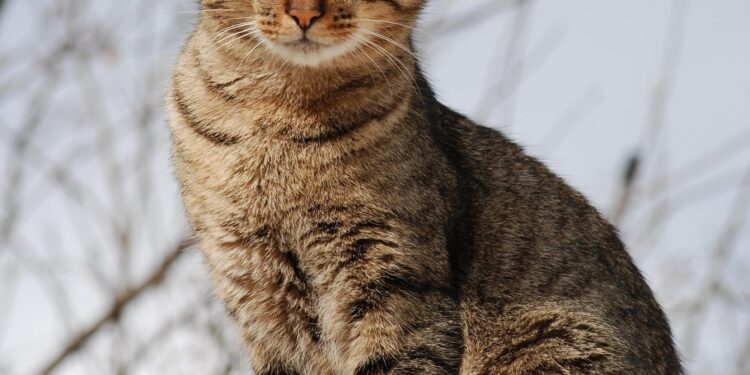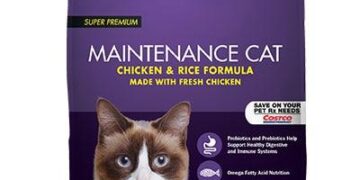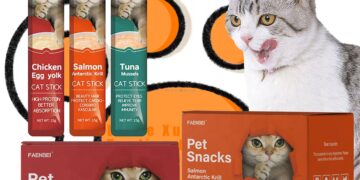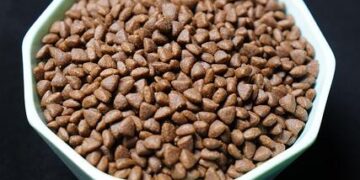Table of Contents
The Feline Nutritional Blueprint: Why Cats Are Not Small Dogs
To select an appropriate diet for any species, one must first understand its fundamental biology.
For the domestic cat (Felis catus), this principle is paramount, as its metabolic and physiological framework is uniquely specialized and starkly different from that of omnivores like dogs or humans.
Choosing a food, particularly a dry formulation, without a deep appreciation for this biological blueprint is a significant contributor to many of the chronic diseases prevalent in the modern feline population.
The Obligate Carnivore: Deconstructing a Cat’s Ancestral Diet
The term “obligate carnivore” is not a dietary preference; it is a biological mandate.1
Unlike facultative carnivores (like dogs), which can derive nutrients from plant matter, a cat’s entire physiology—from its dental structure to its metabolic pathways—is exclusively adapted to process and thrive on animal tissues.3
For millions of years, the ancestors of the domestic cat, such as
Felis silvestris, subsisted on a diet of small prey like rodents, birds, and insects.4
Analysis of this ancestral diet provides a nutritional gold standard.
The typical prey consumed by feral cats consists of approximately 52% protein, 46% fat, and a mere 2% carbohydrates on a metabolizable energy basis.4
This macronutrient profile—high in protein, moderate in fat, and exceptionally low in carbohydrates—is the benchmark to which a cat’s digestive system and metabolism are tuned.
While domestication has altered a cat’s environment, it has not fundamentally changed these core nutritional requirements.3
This evolutionary reality must inform every decision regarding feline nutrition.
The Critical Role of Animal-Based Protein and Taurine
The necessity for animal tissue in a cat’s diet is rooted in its specific amino acid requirements.
Cats have a higher baseline need for protein than most other mammals, and critically, they cannot efficiently synthesize certain essential amino acids from plant-based precursors.3
Nutrients like arginine, methionine, and lysine must be obtained from animal sources in sufficient quantities to support vital functions, including growth and immune response.3
Among these, taurine holds a place of special importance.
Cats have a limited ability to synthesize taurine and therefore must acquire it directly from their diet, where it is abundant in animal muscle, heart, and liver tissue but absent from plants.2
A deficiency in taurine can lead to severe and often irreversible health consequences, including feline central retinal degeneration (leading to blindness) and dilated cardiomyopathy (a serious heart condition).2
Recognizing this, the Association of American Feed Control Officials (AAFCO) has established a minimum requirement for taurine in commercial dry cat food of 25 mg per 100 kcal of metabolizable energy.6
This serves as a non-negotiable baseline for any acceptable dry food formulation.
The Moisture Imperative: A Low Thirst Drive in a Modern World
The domestic cat evolved from desert-dwelling ancestors, a heritage that endowed it with highly efficient kidneys capable of concentrating urine to conserve water.9
A direct consequence of this adaptation is a naturally low thirst drive; cats simply do not feel the urge to drink water until they are already in a state of mild dehydration.2
In their natural habitat, this was not a liability, as their prey is composed of 70-80% water, providing nearly all of their hydration needs through food.1
This evolutionary trait becomes a critical vulnerability in the context of modern pet food.
Dry kibble, by its nature, contains a very low moisture content, typically ranging from 6-10%.10
A cat subsisting on a diet of only dry food is forced to compensate for this massive moisture deficit by drinking free water.
However, studies and veterinary observations consistently show that even with a water bowl available, cats on a dry-food diet consume significantly less total water than cats on a wet-food diet.1
This leads to a state of chronic, low-level dehydration, which places immense, continuous stress on the kidneys and results in persistently concentrated urine—a primary factor in the development of urinary tract diseases.10
Carbohydrates: An Unnatural Energy Source for the Feline Metabolism
A cat’s metabolic machinery for handling carbohydrates is profoundly different from that of an omnivore.
The digestive process for starches begins in the mouth with the enzyme salivary amylase, an enzyme that cats lack entirely.13
Their capacity to digest carbohydrates is further limited by significantly lower levels of pancreatic amylase and other intestinal enzymes compared to dogs.13
Furthermore, a cat’s liver lacks glucokinase, a key enzyme responsible for processing large influxes of glucose from the bloodstream after a carbohydrate-rich meal.15
While cats do possess other enzymes that allow them to digest and utilize carbohydrates for energy, their system is easily overwhelmed by the high carbohydrate loads found in many commercial dry foods.14
The feline metabolism is perpetually geared for gluconeogenesis—the process of creating glucose from protein and fat—and it continues this process even when dietary carbohydrates are present.13
This means that while cats have no demonstrated dietary requirement for carbohydrates (except possibly during gestation and lactation), their bodies are optimized to derive energy from protein and fat.13
The introduction of a high-carbohydrate diet forces an unnatural metabolic burden upon their system, with significant health consequences.
The combination of a low thirst drive and an inefficient carbohydrate metabolism creates a synergistic effect when a cat is fed a diet of conventional dry kibble.
The chronic dehydration from the low-moisture food concentrates urine and strains the kidneys, while the high carbohydrate load simultaneously places the pancreas and liver under metabolic stress.
It is this compounding of physiological insults—not just one factor alone—that drives the high incidence of kidney disease, urinary tract disorders, and diabetes in the modern feline population.9
A choice of food is therefore not merely a matter of preference but a critical act of preventative medicine that must account for these interconnected biological realities.
The Kibble Paradox: Convenience vs. Biological Appropriateness
Dry cat food, or kibble, dominates the pet food market due to its undeniable advantages for the human owner: it is cost-effective, convenient to store and serve, and has a long shelf life.11
However, this convenience comes at a significant biological cost to the cat.
The very nature of its manufacturing process and its final composition are often in direct opposition to the feline nutritional blueprint established in the previous section.
The Manufacturing Process: Why Dry Food is High in Carbohydrates
The ubiquitous shape and texture of kibble are products of a manufacturing process called extrusion.
During this process, ingredients are mixed into a dough, cooked under high pressure and temperature, and then forced through a die that cuts it into the desired shape.13
For this process to work effectively, a significant amount of starch is required to bind the ingredients, form a cohesive dough, and prevent the final product from crumbling.10
This technological necessity is the primary reason why most dry cat foods are high in carbohydrates.
Ingredients like corn, rice, potatoes, or peas serve as the starchy binders essential for extrusion.4
As a result, conventional dry foods typically contain between 20% and 40% of their metabolizable energy from carbohydrates, a stark contrast to the estimated 2% found in a cat’s natural prey.4
This composition is dictated by the needs of the factory, not the needs of the feline.
Additionally, the high-heat processing involved can destroy heat-sensitive nutrients and natural food enzymes, placing a greater digestive burden on the cat’s pancreas.9
A Critical Assessment of Dry Food’s Impact on Feline Health
The long-term consumption of a diet that is fundamentally low in moisture and high in carbohydrates is linked to a cluster of chronic diseases that are distressingly common in domestic cats.
Chronic Dehydration and its Cascade of Consequences
The most immediate and unavoidable consequence of a kibble-based diet is the risk of chronic dehydration.
As established, the 6-10% moisture content of dry food is a fraction of the 70-80% found in natural prey.10
This persistent water deficit leads to the production of highly concentrated urine, which creates an environment ripe for the formation of mineral crystals and stones.9
This condition, broadly known as Feline Lower Urinary Tract Disease (FLUTD), encompasses painful inflammation (cystitis) and the development of struvite or calcium oxalate crystals, which can lead to life-threatening urethral blockages, particularly in male cats.9
For any cat with a history of urinary tract issues, veterinary experts often state that the single most important therapeutic intervention is the complete elimination of dry food from the diet.9
The Triad of Risk: Kidney Disease, Obesity, and Diabetes
Beyond the urinary tract, the composition of dry food poses a threefold threat to a cat’s metabolic health.
- Kidney Disease: The constant strain of processing highly concentrated urine and managing a state of low-grade dehydration places a heavy burden on the kidneys. Over many years, this is considered a significant contributing factor to the development of Chronic Kidney Disease (CKD), one of the leading causes of mortality in senior cats.10
- Obesity: Dry food is exceptionally calorie-dense, and its high carbohydrate content is readily converted to fat in a carnivorous metabolism.10 When combined with the common practice of “free-feeding”—leaving a full bowl of food out at all times—it creates a perfect recipe for weight gain. This has led to an epidemic of feline obesity, which in turn predisposes cats to a host of secondary health problems, including arthritis and liver disease.9
- Diabetes: The high glycemic load of the carbohydrates in kibble causes rapid spikes in blood sugar. In a free-fed cat that nibbles 15-20 times a day, this results in repeated demands on the pancreas to secrete insulin.9 Over time, the body’s cells can become resistant to the effects of insulin, leading to the development of Type 2 diabetes.9 The link is so strong that a majority of diabetic cats—at least 70%—can achieve diabetic remission simply by switching to a low-carbohydrate, high-moisture canned or raw diet.9
The widespread use of conventional dry food has created a troubling feedback loop within the pet care industry.
The very diseases that are caused or exacerbated by high-carbohydrate, low-moisture diets—such as diabetes, urinary issues, and kidney disease—are the primary targets for a multi-billion dollar market of veterinary prescription diets.17
Often, these therapeutic foods are also sold in a dry format, attempting to manage a condition with a formulation that shares the same fundamental flaws as the food that may have contributed to it in the first place.
A proactive owner, by understanding this cycle, can potentially circumvent the need for expensive, long-term medical management by choosing a more biologically appropriate non-prescription food from the outset.
Making an Informed Choice: When and Why to Consider Dry Food
Despite these significant biological drawbacks, dry food remains a practical reality for many cat owners.
Its affordability, ease of use, and stability make it an accessible option, particularly in multi-cat households or for owners with demanding schedules.11
Furthermore, some cats develop strong textural preferences and may refuse to eat wet food, making a high-quality dry food the only viable option to ensure they are receiving adequate nutrition.19
In these situations, the principle of “fed is best” applies, but it should be viewed as a starting point for optimization, not a final destination.19
The goal then becomes to mitigate the inherent risks of kibble by selecting the most species-appropriate formulation available and implementing management strategies to counteract its deficiencies.
The Educated Consumer’s Toolkit: How to Decode Any Cat Food Label
Navigating the cat food aisle requires more than just an understanding of feline nutrition; it requires literacy in the complex and often misleading language of pet food labeling.
The package is a legal document governed by specific regulations, but it is also a powerful marketing tool.20
Learning to separate mandated fact from marketing fiction is the most critical skill for any cat owner.
Beyond the Marketing: Mastering the AAFCO Nutritional Adequacy Statement
While flashy graphics and appealing product names dominate the front of the bag, the most important information is often found in small print on the back.
The Nutritional Adequacy Statement is a legally required declaration that specifies the species and life stage for which the food is intended.20
This statement is the consumer’s primary assurance that the product provides all essential nutrients in the correct proportions.
Key phrases to look for are:
- “Complete and Balanced”: This signifies that the food can be fed as a sole source of nutrition.21 Foods labeled as “treats,” “snacks,” or “for intermittent or supplemental feeding only” are not nutritionally complete.
- Life Stage: AAFCO recognizes three primary life stages for cats: Growth (kittens), Adult Maintenance, and Gestation/Lactation. A food may also be approved for “All Life Stages,” meaning it meets the more demanding nutritional requirements of kittens. It is crucial to match the food to your cat’s specific life stage.20
This statement can be substantiated in one of two ways:
- “…formulated to meet the nutritional levels established by the AAFCO Cat Food Nutrient Profiles…”: This means the food was created based on a recipe that meets the minimum (and sometimes maximum) nutrient requirements on paper.
- “Animal feeding tests using AAFCO procedures substantiate that [Product Name] provides complete and balanced nutrition…”: This is a higher standard, indicating the food was fed to cats in a controlled trial to verify its nutritional adequacy and digestibility.21
The Ingredient List: A Forensic Analysis of What’s Really Inside
The ingredient list provides a window into the food’s composition, with one cardinal rule: ingredients are listed in descending order of their weight before processing.20
This rule, however, can be used to create a perception of quality that may not reflect the final product.
Identifying High-Quality Proteins
- Whole Meat vs. Meat Meal: Seeing “Deboned Chicken” as the first ingredient is appealing. However, whole chicken is about 70% water, most of which is removed during the extrusion process to make dry kibble.20 In contrast, “Chicken Meal” is a rendered product where the water and some fat have already been removed, creating a highly concentrated source of protein.16 Consequently, a food listing “Chicken Meal” as the second or third ingredient may ultimately contain more animal protein than a food listing “Chicken” first, followed by several carbohydrate sources. A truly high-quality food will often feature multiple named animal proteins, both whole and in meal form, within the first several ingredients.
- By-Products: The term “meat by-products” refers to non-rendered, clean parts of slaughtered animals other than muscle meat, such as lungs, spleen, kidneys, and liver.22 While these can be highly nutritious, the lack of specificity is a concern. “Chicken by-product meal” is preferable to the generic “meat by-products,” as it at least identifies the source species.
Evaluating Carbohydrate and Fiber Sources
Scan the ingredient list for common carbohydrate sources like corn, wheat, soy, peas, potatoes, and tapioca.10
Their position on the list is a direct indicator of the food’s carbohydrate load.
If these ingredients appear before the second or third named animal protein source, it is a strong sign that the food is high in carbohydrates and may be less biologically appropriate for your cat.
The Guaranteed Analysis: Calculating What Truly Matters
The Guaranteed Analysis (GA) panel provides minimum percentages for crude protein and fat, and maximum percentages for crude fiber and moisture.21
Because these are not exact values, a direct comparison between two products based on the GA alone can be misleading.20
However, this panel contains the raw data needed to uncover the most critical, yet unlisted, piece of information: the carbohydrate content.
A Step-by-Step Guide to Calculating Carbohydrate Content (Dry Matter Basis)
Since manufacturers are not required to list carbohydrate content, the consumer must calculate it themselves.
Converting the values to a Dry Matter Basis (DMB) removes the variable of moisture, allowing for an accurate, apples-to-apples comparison between any two foods, wet or dry.
The following table provides a worksheet for this essential calculation.
Table 1: Carbohydrate Calculation Worksheet
| Step | Action | Example Calculation |
| 1 | List Guaranteed Analysis Values (As Fed %) | Protein: 43.0% Fat: 19.0% Fiber: 3.5% Moisture: 10.0% Ash: 9.9%* |
| 2 | Calculate Total Non-Carb Components Add the percentages from Step 1. | 43.0+19.0+3.5+10.0+9.9=85.4% |
| 3 | Calculate Carbohydrate % (As Fed) 100%− | 100%−85.4%=14.6% |
| 4 | Calculate Dry Matter % 100%− | 100%−10.0%=90.0% |
| 5 | Calculate Carbohydrate % (DMB) [Carb % (As Fed)]÷×100 | (14.6%÷90.0%)×100=16.2% |
*Note: Ash (the mineral content) is not always listed.
If it is unavailable, a reasonable estimate for dry cat food is 7-8%.23
The example uses a listed value from a specific product for accuracy.24
By mastering this calculation, a consumer is no longer reliant on marketing claims.
They are empowered to quantitatively assess any dry food against the biological standard of a low-carbohydrate diet, transforming the label from a marketing tool into a transparent data sheet.
Navigating Modern Feline Diets: Grain-Free, Human-Grade, and Beyond
The premium pet food market has evolved, with marketing terms that sound scientific and healthful.
However, these labels can create a “health halo” around products that may not be fundamentally different in their nutritional composition.
A critical eye is needed to distinguish meaningful quality improvements from sophisticated marketing.
The Grain-Free Debate: Separating Scientific Fact from Marketing Fiction
The “grain-free” trend is one of the most pervasive in the pet food industry.
It is built on the correct premise that cats, as carnivores, do not require grains in their diet.
However, the conclusion that “grain-free” is therefore synonymous with “healthy” or “low-carbohydrate” is often false.25
The primary issue with grains like corn and wheat in cat food is their high starch content, which contributes to an excessive carbohydrate load.22
Many grain-free formulas simply replace these grains with other high-carbohydrate ingredients, such as potatoes, sweet potatoes, peas, lentils, or tapioca.10
A 2017 study found that some grain-free cat foods actually had higher carbohydrate counts than their grain-containing counterparts.25
While true grain allergies are exceedingly rare in cats, the metabolic problems associated with high carbohydrate intake are common.26
Therefore, the crucial metric is not the absence of grains, but the total calculated carbohydrate percentage of the food.
A grain-free food with 35% carbohydrates from potatoes is no more biologically appropriate than a food with 35% carbohydrates from corn.
The “Human-Grade” Standard: A Meaningful Mark of Quality?
The term “human-grade” signifies that the ingredients used in the pet food are sourced from the human food supply chain and manufactured in a facility licensed for human food production.27
This stands in contrast to “feed-grade” ingredients, which are subject to different regulations and can legally include materials not fit for human consumption, such as meat from “4D” animals (dead, dying, diseased, or disabled).28
Opting for a human-grade food offers tangible benefits in terms of safety and quality control.
These foods are less likely to contain harmful contaminants and are often made with more digestible, higher-quality whole-food ingredients.28
However, “human-grade” is a statement about ingredient sourcing and safety, not nutritional formulation.27
A cat food made with human-grade chicken, turkey, and salmon is excellent, but a food made with human-grade potatoes, peas, and carrots is still a high-carbohydrate diet that is inappropriate for a cat’s metabolism.
The human-grade designation is a valuable indicator of quality, but it must be considered in conjunction with, not as a replacement for, a thorough analysis of the food’s macronutrient profile.
Evaluating Specialized Formulas: Indoor, Weight Control, and Life Stage Diets
Manufacturers offer a wide array of specialized formulas targeting specific needs.
- “Indoor” formulas often feature slightly reduced calories to match a less active lifestyle and may include added fiber, such as beet pulp, to help manage hairballs.30
- “Weight Control” formulas typically lower the fat content and increase fiber to help a cat feel full while consuming fewer calories. They may also include supplements like L-carnitine to support a healthy metabolism.30
- “Kitten” formulas are formulated with higher levels of protein, fat, and calories, along with specific nutrients like DHA, to support rapid growth and development.30
While these formulas can be beneficial, they should not be accepted at face value.
The same core principles of evaluation must be applied.
A “weight control” formula that achieves its low-calorie target by replacing fat with excessive carbohydrates is a poor choice for a carnivorous cat.
Always prioritize high levels of animal-based protein and a low total carbohydrate load, regardless of the product’s specific marketing angle.
A Curated Analysis of High-Quality Dry Cat Foods
Applying the rigorous analytical framework developed in the preceding sections, it is possible to identify a class of dry cat foods that, while still a biological compromise, represent the best available options for owners who choose to feed kibble.
This section provides an in-depth analysis of several leading brands that prioritize species-appropriate nutrition.
Establishing the Gold Standard: Criteria for Top-Tier Kibble
A superior dry cat food is one that comes closest to mimicking the macronutrient profile of a cat’s natural prey, within the constraints of the extrusion process.
The following criteria serve as a benchmark for evaluation:
- High Animal-Based Protein: A minimum crude protein of 40% is the target, reflecting a diet centered on meat.
- Low Carbohydrates: The calculated carbohydrate content on a Dry Matter Basis (DMB) should be under 20%, with formulas under 15% being exceptional.
- Named Animal Protein First: The first three to five ingredients should be clearly identified animal sources, such as “Deboned Chicken,” “Chicken Meal,” or “Herring Meal”.16
- AAFCO Compliance: The food must carry a “Complete and Balanced” nutritional adequacy statement for the appropriate life stage.20
- Adequate Animal Fat: A minimum crude fat of 18% from named animal sources like “chicken fat” or “salmon oil” is desirable for energy and essential fatty acids.
- No Low-Quality Fillers: The formula should avoid high concentrations of corn, wheat, or soy, particularly in the top half of the ingredient list.22
In-Depth Brand Profiles: Nutritional and Ingredient Analysis
The premium dry cat food market can be seen as having two distinct philosophical approaches.
One camp includes long-standing, research-focused brands (often recommended by veterinarians) that create formulas for specific health conditions but may still contain moderate carbohydrate levels.30
The other camp consists of newer brands that adhere to an “ancestral diet” or “biologically appropriate” model, prioritizing high protein and low carbohydrates above all else.35
The following analysis focuses on brands from this latter group, as their philosophy aligns most closely with the nutritional principles outlined in this report.
The Protein Powerhouses: Dr. Elsey’s cleanprotein & Orijen
- Dr. Elsey’s cleanprotein: This brand is engineered with the primary goal of maximizing animal protein and minimizing carbohydrates to emulate a cat’s natural prey. Their formulas boast some of the highest protein levels in the industry, with over 90% of the protein being animal-based.35 A key differentiator is their focus on creating a low-oxalate diet by avoiding plant ingredients like spinach and sweet potatoes, which may help support long-term kidney health.35
- Orijen: Orijen operates on a “Biologically Appropriate” and “WholePrey” philosophy. Their formulas feature exceptionally high inclusions of animal ingredients (up to 90%), incorporating not just muscle meat but also nutrient-dense organs, cartilage, and bone to mimic the composition of a whole prey animal.36 The first five ingredients in their foods are consistently fresh or raw animal sources, and their recipes are grain-free, using lentils and chickpeas for binding.36
The Ethical and Transparent Choice: Open Farm
- Open Farm: This brand distinguishes itself through an unparalleled commitment to ethical sourcing and transparency. They use humanely raised chicken and turkey and sustainably caught fish, and their sourcing is certified by third-party organizations like Global Animal Partnership.39 A unique feature is their traceability technology, which allows consumers to enter a lot code from the bag to see the origin of every single ingredient.41 While their protein and carbohydrate levels are very good, their primary value proposition lies in ingredient quality and ethical peace of mind.
The Carnivore-Focused Challenger: Tiki Cat Born Carnivore
- Tiki Cat Born Carnivore: Known primarily for their high-quality wet foods, Tiki Cat’s dry food line applies a similar carnivore-focused philosophy. Their formulas feature high protein levels (42% or more) with real meat or fish as the first ingredient.42 They utilize grain-free carbohydrate sources like peas and chickpeas and avoid processed plant proteins like corn gluten meal.24 The kibble is gently baked, a process intended to preserve nutrients and enhance flavor.44
Comparative Analysis of Leading High-Protein, Low-Carbohydrate Dry Foods
The following table provides a direct, quantitative comparison of representative formulas from these top-tier brands, applying the calculation method from Section 3.3.1 to provide a clear picture of their nutritional profiles.
Table 2: Comparative Analysis of Top-Tier Dry Cat Foods
| Brand / Formula | Primary Protein Sources (First 5 Ingredients) | Crude Protein % (Min) | Crude Fat % (Min) | Calculated Carb % (DMB) | Taurine % (Min) | Calories (kcal/cup) | Key Differentiator |
| Dr. Elsey’s cleanprotein Chicken 35 | Chicken, Dried Egg Product, Pork Protein Isolate, Gelatin, Chicken Fat | 59.0% | 18.0% | ~5.7% | Not Listed** | Not Listed | Industry-leading protein levels; low oxalate formulation |
| Orijen Original Cat 36 | Chicken, Turkey, Whole Herring, Turkey Giblets, Salmon | 40.0% | 20.0% | ~18.9% | 0.2% | 515 | “WholePrey” philosophy with high inclusion of fresh/raw ingredients |
| Open Farm Homestead Turkey & Chicken 46 | Turkey, Chicken, Ocean Whitefish Meal, Herring Meal, Chickpeas | 37.0% | 18.0% | ~23.3% | 0.2% | Not Listed | Unmatched ingredient transparency and ethical sourcing |
| Tiki Cat Born Carnivore Chicken Luau 48 | Deboned Chicken, Chicken Meal, Dehydrated Chicken, Dried Egg Product, Tapioca | 43.0% | 19.0% | ~18.3% | 0.14% | 476 | High animal protein from a trusted carnivore-focused brand |
**Carbohydrate calculations are estimates based on Guaranteed Analysis values.
Dr. Elsey’s analysis uses 12% moisture and an estimated 7% ash.
Orijen uses 10% moisture and an estimated 8% ash.
Open Farm uses 10% moisture and an estimated 8% ash.
Tiki Cat uses 10% moisture and an estimated 8.5% ash (derived from other formulas).
*Taurine is an essential ingredient and is included, but not always listed in the Ga.
This analysis demonstrates that while all these brands represent a significant improvement over conventional kibble, there are clear distinctions.
Dr. Elsey’s offers an unparalleled low-carbohydrate profile, while Orijen focuses on fresh ingredient diversity.
Open Farm leads in ethical sourcing, and Tiki Cat provides a strong, balanced option.
This data empowers the consumer to make a final choice based on their specific priorities, whether they be maximizing protein, ensuring ethical sourcing, or achieving a balance of factors.
Practical Implementation and Long-Term Feline Wellness
Selecting a superior dry cat food is only the first step.
The ultimate success of any nutritional strategy depends on proper implementation and a holistic approach to feline care.
The “best” food can still lead to poor health outcomes if managed incorrectly.
Therefore, the final responsibility rests with a knowledgeable and diligent owner.
The Art of Transition: Safely Introducing a New Diet
Cats are notoriously resistant to dietary changes, and a sudden switch can cause digestive upset, such as vomiting or diarrhea.50
Furthermore, many cats become accustomed to the highly palatable animal digest sprays coated on lower-quality kibbles, making them reluctant to try a new food.18
A slow, patient transition is essential for success.
The recommended method is a gradual introduction over 7 to 10 days:
- Days 1-3: Serve a mixture of 75% old food and 25% new food.
- Days 4-6: Adjust the ratio to 50% old food and 50% new food.
- Days 7-9: Move to 25% old food and 75% new food.
- Day 10: Serve 100% new food.
For particularly stubborn cats, you may need to extend this timeline.
Patience is key; do not panic and revert to the old food if your cat is hesitant at first.18
Beyond the Bowl: The Importance of Hydration, Portion Control, and Monitoring
Managing the risks inherent in a dry diet requires proactive effort from the owner.
- Hydration: Because dry food provides minimal moisture, maximizing water intake is critical. Place multiple, wide water bowls throughout the house, away from food and litter boxes. A water fountain is highly recommended, as many cats are attracted to the movement and sound of running water, which encourages them to drink more frequently.16
- Portion Control: Free-feeding calorie-dense kibble is a primary cause of feline obesity.10 It is imperative to feed distinct meals two to three times per day, using a measuring cup to ensure accurate portions. The feeding guidelines on the package are a starting point; adjust the amount based on your cat’s age, activity level, and body condition.11 As a general rule, a typical adult indoor cat requires approximately 200-250 calories per day, or about 25-30 calories per pound of ideal body weight.11
- Monitoring: After transitioning to a new food, closely observe your cat for signs of how well they are tolerating it. Pay attention to their energy level, coat quality, and stool consistency. A healthy response includes firm, less odorous stools, a shiny coat, and consistent energy.19 Any persistent digestive upset or negative changes warrant a consultation with your veterinarian.
Concluding Recommendations: A Framework for Lifelong Nutritional Success
The evidence presented in this report leads to a clear set of conclusions.
The domestic cat is an obligate carnivore whose health is best supported by a diet high in animal-based protein and moisture, and low in carbohydrates.
While dry food offers convenience, its composition represents a significant biological compromise that is linked to a range of chronic diseases.
Therefore, the optimal approach for feline nutrition involves prioritizing moisture.
The ideal diet consists primarily of a high-quality, low-carbohydrate wet food.
However, for owners who must or choose to use dry food, the following framework is recommended:
- Select the Best Possible Kibble: Use the tools and criteria in this report to choose a dry food with the highest possible animal protein content (ideally >40%) and the lowest possible calculated carbohydrate content (ideally <20% DMB).
- Implement a Mixed-Feeding Strategy: Whenever possible, do not rely on dry food exclusively. Incorporate at least one daily meal of high-quality wet food to provide essential hydration and high-quality animal protein.11 This “best of both worlds” approach can significantly mitigate the risks of a dry-only diet.
- Manage the Environment: Actively promote hydration with water fountains and enforce strict portion control with measured meals. Do not free-feed.
By embracing the role of a proactive and educated pet parent, you can move beyond marketing claims and make evidence-based nutritional decisions.
This strategic management—combining a superior product with diligent care practices—provides the most effective path toward ensuring the long-term health and wellness of your feline companion.
Works cited
- Cats Are Carnivores: How To Meet Your Cat’s Dietary Needs, accessed August 15, 2025, https://vetmed.tamu.edu/news/pet-talk/cats-are-carnivores-so-they-should-eat-like-one/
- Understanding Cat Nutrition: What Does It Really Mean to Feed a Carnivore? – TICA, accessed August 15, 2025, https://tica.org/blogs/understanding-cat-nutrition-what-does-it-really-mean-to-feed-a-carnivore/
- Cats are Obligate Carnivores: Understanding Your Cat’s Nutritional Needs – Tiki Pets, accessed August 15, 2025, https://tikipets.com/the-obligate-carnivore-diet-understanding-your-cats-nutritional-needs/
- Cats and Carbohydrates: The Carnivore Fantasy? – PMC, accessed August 15, 2025, https://pmc.ncbi.nlm.nih.gov/articles/PMC5753635/
- Feline Nutrition | VMBS News – Texas A&M College of Veterinary Medicine, accessed August 15, 2025, https://vetmed.tamu.edu/news/pet-talk/feline-nutrition/
- Why taurine is so important for cats and dogs | Royal Canin US, accessed August 15, 2025, https://www.royalcanin.com/us/about-us/our-nutritional-approach/why-taurine-is-so-important-for-cats-and-dogs
- The taurine requirement of the adult cat – ResearchGate, accessed August 15, 2025, https://www.researchgate.net/publication/230204315_The_taurine_requirement_of_the_adult_cat
- www.royalcanin.com, accessed August 15, 2025, https://www.royalcanin.com/us/about-us/our-nutritional-approach/why-taurine-is-so-important-for-cats-and-dogs#:~:text=How%20much%20taurine%20do%20cats,Control%20Officials%20Publication%2C%202021).
- 10 Reasons Why Dry Food Is Bad for Cats & Dogs | Little Big Cat …, accessed August 15, 2025, https://littlebigcat.com/why-dry-food-is-bad-for-cats-and-dogs/
- Food For Thought: The Hidden Risks of Dry Cat Food – SAVANNAHGANS, accessed August 15, 2025, https://www.savannahgans.com/blog-1/dry-cat-food
- Cat Food Dilemma: Wet vs. Dry – Making the Right Choice | GoodVets, accessed August 15, 2025, https://goodvets.com/journal/choosing-the-right-cat-food-wet-food-vs-dry-food
- The Dangers of Kitty Crack: Why Dry Cat Food Is a No-Go, accessed August 15, 2025, https://rawdogfoodandco.com/the-dangers-of-kitty-crack-why-dry-cat-food-is-a-no-go/
- Cats and Carbohydrates: Fueling Your Feline – Diamond Pet Foods, accessed August 15, 2025, https://www.diamondpet.com/blog/health/weight-management/cats-and-carbohydrates/
- Cats and Carbohydrates – What is the Impact? – WSAVA2011 – VIN, accessed August 15, 2025, https://www.vin.com/apputil/content/defaultadv1.aspx?id=5189562&pid=11343
- A Complete Guide on Cats and Carbohydrates – The Honest Kitchen, accessed August 15, 2025, https://www.thehonestkitchen.com/blogs/pet-wellness/carbs-in-cat-food
- Are all dry cat foods really as bad as the internet says? : r/CatAdvice – Reddit, accessed August 15, 2025, https://www.reddit.com/r/CatAdvice/comments/1j8abmw/are_all_dry_cat_foods_really_as_bad_as_the/
- Dry cat food – PMC, accessed August 15, 2025, https://pmc.ncbi.nlm.nih.gov/articles/PMC2034416/
- Transitioning Dry Food Addicts to Canned Food – Cats Exclusive Veterinary Center, accessed August 15, 2025, https://www.catsexclusive.com/educational-resources/transitioning-dry-food-addicts-to-canned-food
- Am I a bad cat owner for feeding my cats dry food? : r/CatAdvice – Reddit, accessed August 15, 2025, https://www.reddit.com/r/CatAdvice/comments/15wan0q/am_i_a_bad_cat_owner_for_feeding_my_cats_dry_food/
- Deciphering Cat Food Labels | VCA Animal Hospitals, accessed August 15, 2025, https://vcahospitals.com/know-your-pet/deciphering-cat-food-labels
- Reading Labels | AAFCO, accessed August 15, 2025, https://www.aafco.org/consumers/understanding-pet-food/reading-labels/
- Google is useless. anyone know the best DRY cat food? : r/catfood – Reddit, accessed August 15, 2025, https://www.reddit.com/r/catfood/comments/1g53s7f/google_is_useless_anyone_know_the_best_dry_cat/
- Carb calculator for cat food [dry matter] – Jess Caticles, accessed August 15, 2025, https://caticles.com/carb-calculator-for-cat-food/
- Tiki Cat Born Carnivore Dry Cat Food | Only Natural Pet, accessed August 15, 2025, https://www.onlynaturalpet.com/products/tiki-cat-born-carnivore-dry-cat-food
- Is Grain Free Food Bad for Cats? – The Honest Kitchen, accessed August 15, 2025, https://www.thehonestkitchen.com/blogs/pet-food-ingredients/is-a-grain-free-diet-best-for-cats-qa-with-dr-leilani-alvarez-dvm
- Is Grain-Free Cat Food Better? – PetMD, accessed August 15, 2025, https://www.petmd.com/cat/nutrition/grain-free-cat-food-better
- Does human-grade cat food make a real difference for feline health?, accessed August 15, 2025, https://untamed.com/blogs/nutrition/human-grade-cat-food
- 7 Benefits of Human Grade Cat Food – The Honest Kitchen, accessed August 15, 2025, https://www.thehonestkitchen.com/blogs/pet-food-ingredients/7-benefits-of-human-grade-cat-food
- Why Choose Human Grade Cat Food: 3 Game-Changing Reasons – Talis Us, accessed August 15, 2025, https://talis-us.com/blogs/news/why-choose-human-grade-cat-food-3-game-changing-reasons
- 10 Best Cat Foods in 2025, Recommended By Vets – PetMD, accessed August 15, 2025, https://www.petmd.com/cat/vet-verified/best-cat-food
- What Is the Healthiest Dry Cat Food for Indoor Cats: A Health-Focused Guide – Ibiyaya, accessed August 15, 2025, https://ibiyaya-usa.com/blog/what-are-the-healthiest-dry-indoor-cat-food/
- Low Carb Dry Cat Food – Petco, accessed August 15, 2025, https://www.petco.com/shop/en/petcostore/o/low-carb-dry-cat-food
- High Protein Cat Food in Cat Food – Walmart.com, accessed August 15, 2025, https://www.walmart.com/browse/pets/high-protein-cat-food/5440_202073_1749780_1877633
- Can anyone recommend a good high protein dry food with no raw ingredients? – Reddit, accessed August 15, 2025, https://www.reddit.com/r/FIVcats/comments/1g3taht/can_anyone_recommend_a_good_high_protein_dry_food/
- Dr. Elsey’s cleanprotein™ Chicken Recipe Dry Kibble Cat Food, accessed August 15, 2025, https://www.drelseys.com/products/chicken-recipe/
- Original Cat Dry Cat Food – ORIJEN, accessed August 15, 2025, https://www.orijenpetfoods.com/en-US/cats/cat-food/original-cat/ds-ori-cat-kitten.html
- Dr. Elsey’s cleanprotein™ Pork Recipe Dry Kibble Cat Food, accessed August 15, 2025, https://www.drelseys.com/products/pork-recipe-kibble/
- ORIJEN Original Grain-Free High-Protein Premium Dry Cat Food, 7-lb bag – Chewy.com, accessed August 15, 2025, https://www.chewy.com/orijen-original-grain-free-dry-cat/dp/29728
- Dry Kitten Food – Grain Free Kitten Food – Open Farm, accessed August 15, 2025, https://openfarmpet.com/products/dry-kitten-food
- RawMix Open Prairie Grain-Free Cat Kibble, accessed August 15, 2025, https://openfarmpet.com/products/open-prairie-recipe-for-cats
- 10 Best Healthy Dry Cat Foods: Unbiased Review – Cats.com, accessed August 15, 2025, https://cats.com/best-dry-cat-food
- Tiki Cat Born Carnivore Chicken, Herring & Salmon Meal Dry Cat Food – Pet Food Express, accessed August 15, 2025, https://www.petfood.express/products/tiki-cat-born-carnivore-chicken-herring-salmon-meal-dry-cat-food.html
- Tiki Cat® Born Carnivore™ Fish Luau – High Protein, accessed August 15, 2025, https://tikipets.com/product/tiki-cat/tiki-cat-dry-food/born-carnivore/fish-luau/
- Tiki Cat Born Carnivore Dry Cat Food, High Protein, Chicken & Egg, 11.1-lb – Mud Bay, accessed August 15, 2025, https://www.mudbay.com/cat/cat-food/dry/tiki-cat-born-carnivore-dry-cat-food-high-protein-chicken-%26-egg-11.1-lb/1016352.html
- What’s in previous versions of cleanprotein™? | Dr. Elsey’s, accessed August 15, 2025, https://www.drelseys.com/faqs/whats-in-previous-versions-of-cleanprotein/
- Homestead Turkey & Chicken Dry Cat Food | Open Farm, accessed August 15, 2025, https://openfarmpet.com/products/homestead-turkey-chicken-dry-cat-food
- Open Farm Grain Free Homestead Turkey & Chicken Recipe Dry Cat Food, accessed August 15, 2025, https://www.petfood.express/products/open-farm-grain-free-homestead-turkey-chicken-recipe-dry-cat-food.html
- Tiki Cat® Born Carnivore™ Chicken Luau – High Protein, accessed August 15, 2025, https://tikipets.com/product/tiki-cat/tiki-cat-dry-food/born-carnivore/chicken-luau/
- TIKI CAT Born Carnivore High Protein Chicken, Herring & Salmon Meal Dry Cat Food, 22.2-lb bundle – Chewy, accessed August 15, 2025, https://www.chewy.com/tiki-cat-born-carnivore-chicken/dp/172041
- Addressing Concerns When a Cat Refuses Dry Food – Under the Weather Pet, accessed August 15, 2025, https://www.undertheweatherpet.com/blogs/under-the-weather/dry-food-dilemma-addressing-concerns-when-a-cat-refuses-dry-food
- Switching Pet Foods – Cats – Purina Institute, accessed August 15, 2025, https://www.purinainstitute.com/centresquare/understanding-pet-food/switching-pet-foods-cats






